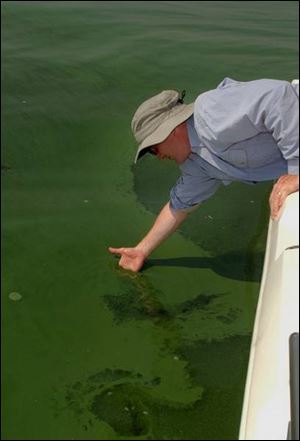
Green algae bloom likely in 2 weeks
8/5/2006
University of Toledo professor Tom Bridgeman checks algae in Maumee Bay in 2003. The slimy green stuff is back again.
It's baaaaaaack.
That pea-green algae capable of killing people has reared its ugly head in Maumee Bay and other parts of western Lake Erie as well as points to the east from Sandusky Bay to Kelleys Island.
Tom Bridgeman, a staff scientist at the University of Toledo's Lake Erie Center, said he came across some microcystis in western Lake Erie's water column while sampling near the Toledo shipping channel recently.
It's not the earliest it's been found here. Nor is it the latest.
Mr. Bridgeman said he expects the algae to be in full bloom and noticeable to boaters in two weeks, based on past experience.
The Toledo area is normally the first place microcystis shows up because western Lake Erie is the shallowest and, therefore, the warmest part of the Great Lakes. The water temperature off Toledo yesterday was 78 degrees, according to the National Weather Service.
The western edge of the lake is also one of the most impacted by sewage overflows and farm runoff.
Matt Thomas, assistant manager of Ohio State University's Stone Laboratory on Gibraltar Island, near Put-in-Bay, said yesterday he's seen microcystis in water drawn between Sandusky Bay and Kelleys Island.
He's not the only one.
Joe Conroy, an Ohio State University doctoral candidate, collected a large amount of microcystis this week from Sandusky Bay. Some of that bay's algae is believed to have flowed into the lake by now, aided by recent storms, said David Culver, an algae expert who has testified to Congress in recent years. Mr. Culver is head of OSU's limnology lab.
Mr. Thomas agreed that the algae will probably be noticeable to boaters in two weeks. "We're not at that stage yet, but conditions are favorable for an algae bloom," Mr. Thomas said.
A lot depends on how the remaining summer heat and rain interacts with the water. Rain pushes nutrients off farms into streams and rivers that flow to the lake.
Heavy storms force raw sewage from Toledo, Defiance, and other cities to flow into the Maumee River or other Lake Erie tributaries. That includes the Detroit River, which carries Detroit's sewage overflow south toward Lake Erie's western basin.
Mr. Bridgeman said runoff is a bigger factor than heat. Lake Erie's phosphorus - a nutrient in sewage, manure, and farm products - has been on the rise since 1997 after a 25-year decline.
"Rainfall in northern Ohio usually means runoff," said Mr. Thomas, who added that he "wouldn't be surprised to see a large bloom of microcystis."
July was the region's wettest on record. But microcystis is fluky: Last summer was one of its earliest arrivals, despite 2005 having an unusually cool spring and one of its driest Junes.
Microcystis is a toxic form of blue-green algae that has appeared in western Lake Erie almost every summer since 1995, after an absence of more than 20 years.
For reasons unknown, it made a comeback. But even now, when it's expected, it doesn't always emerge.
It's normally gone by late September, when fall temperatures set in and the water cools.
Though it's the same type of algae linked to as many as 75 deaths in Brazil in 1996, no deaths in North America have been attributed to it.
Carbon-activated filtration systems used by shoreline municipal water plants, including Toledo's, neutralize it long before it reaches public water supplies.
The Brazilian deaths occurred at a kidney dialysis center where there was a malfunction with the water treatment system, allowing contaminated water to come in contact with patients. The U.S. Centers for Disease Control and Prevention was among the agencies that investigated that case.
Contact Tom Henry at:
thenry@theblade.com
or 419-724-6079.